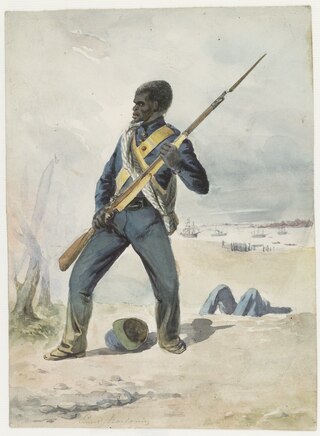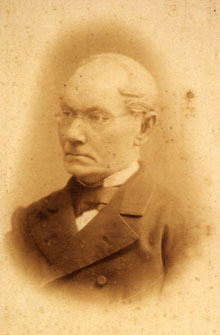Related Research Articles
Osei Bonsu also known as Osei Tutu Kwame was the Asantehene. He reigned either from 1800 to 1824 or from 1804 to 1824. During his reign as the king, the Ashanti fought the Fante confederation and ended up dominating Gold Coast trade. In Akan, Bonsu means whale, and is symbolic of his achievement of extending the Ashanti Empire to the coast. He died in Kumasi, and was succeeded by Osei Yaw Akoto.

Cape Coast Castle is one of about forty "slave castles", or large commercial forts, built on the Gold Coast of West Africa by European traders. It was originally a Portuguese "feitoria" or trading post, established in 1555, which was named Cabo Corso.
Okomfo Anokye was the first priest (Okomfo) of the Ashanti Empire. Anokye is known for his participation in the expansion of the empire. He was also the codifier of the constitution and laws of the Ashanti Empire.
Opoku Ware I was the 2nd Asantehene of Oyoko heritage, who ruled the Ashanti Empire. Between 1718 and 1722, Opoku Ware became Asantehene during a period of civil disorder after the death of the 1st Asanthene. From 1720 to 1721, Opoku established his power.

The Dutch Gold Coast or Dutch Guinea, officially Dutch possessions on the Coast of Guinea was a portion of contemporary Ghana that was gradually colonized by the Dutch, beginning in 1612. The Dutch began trading in the area around 1598, joining the Portuguese which had a trading post there since the late 1400s. Eventually, the Dutch Gold Coast became the most important Dutch colony in West Africa after Fort Elmina was captured from the Portuguese in 1637, but fell into disarray after the abolition of the slave trade in the early 19th century. On 6 April 1872, the Dutch Gold Coast was, in accordance with the Anglo-Dutch Treaties of 1870–71, ceded to the United Kingdom.
Akwamu was a state set up by the Akwamu people in present-day Ghana. After migrating from Bono state, the Akan founders of Akwamu settled in Twifo-Heman. The Akwamu led an expansionist empire in the 17th and 18th centuries. At the peak of their empire, Akwamu extended 400 kilometres (250 mi) along the coast from Ouidah, Benin in the East to Winneba, Ghana, in the West.

The Asante, also known as Ashanti in English, are part of the Akan ethnic group and are native to the Ashanti Region of modern-day Ghana. Asantes are the last group to emerge out of the various Akan civilisations. Twi is spoken by over nine million Asante people as their native language.

Belanda Hitam was an Indonesian language term used to refer to Black soldiers recruited by the Dutch colonial empire for service in the Royal Netherlands East Indies Army (KNIL), the colonial army of the Dutch East Indies. The recruitment of Black soldiers into the KNIL resulted from a combination of factors, including the heavy losses suffered by Dutch forces in the Java War and concerns over the reliability of indigenous KNIL troops. Between 1831 and 1872, over 3,000 West Africans, mostly Akan people, were recruited from the Dutch Gold Coast for KNIL service in the East Indies.

The Dutch Slave Coast refers to the trading posts of the Dutch West India Company on the Slave Coast, which lie in contemporary Ghana, Benin, Togo, and Nigeria. The primary purpose of the trading post was to supply slaves for the Dutch colonies in the Americas. Dutch involvement on the Slave Coast started with the establishment of a trading post in Offra in 1660. Later, trade shifted to Ouidah, where the English and French also had a trading post. Political unrest caused the Dutch to abandon their trading post at Ouidah in 1725, now moving to Jaquim, at which place they built Fort Zeelandia. By 1760, the Dutch had abandoned their last trading post in the region.
Jan Niezer was a Euro-African trader in the Dutch Gold Coast. In his day and age, he was the richest Mulatto trader on the Gold Coast. Furthermore, Niezer was an important political figure during the Ashanti wars of the early 19th century. His most important trade interest was the Atlantic slave trade, until it was abolished by the Netherlands in 1814.
Jacob Peter Huydecoper was an early 19th-century Elmina Euro-African civil servant and diplomat on the Dutch Gold Coast.
Pieter Woortman was a slave trader and an administrator of the Dutch West India Company. He was one of the longest-serving Director-General of the Dutch Gold Coast, in office between 1767 and 1769 and from 1769 until his death in 1780.
The Dutch–Ahanta War was a conflict between the Netherlands and the Ahanta between 1837 and 1839. Beginning with a mere economic dispute between the Ahanta and the Dutch, who were based at the Dutch Gold Coast, the conflict ended with the hanging of Ahanta king Badu Bonsu II and the reorganization of the Ahanta state, establishing a Dutch protectorate over the Ahanta.

The Elmina Java Museum is a museum in Elmina, Ghana, dedicated to the history of the so-called Belanda Hitam; soldiers recruited in the 19th century in the Dutch Gold Coast to serve in the Royal Netherlands East Indies Army. The museum is funded by the Edward A. Ulzen Memorial Foundation.

Willem George Frederik Derx was a Dutch civil servant, who made a career in the administration on the Dutch Gold Coast.

Jan Pranger was a Dutch merchant, slave trader and colonial administrator who served as the Director-General of the Dutch Gold Coast from 1730 to 1734. A portrait of him along with an enslaved servant by Dutch artist Frans van der Mijn in on display at the Rijksmuseum in Amsterdam.
Friedrich Franz Ludwich Ulrich Last was a colonial administrator on the Gold Coast.
Adjua Gyapiaba, also known as Ajua Japiaba, Api-jaba and Afi Jaba, was a woman from Elmina in contemporary Ghana, who after a heated argument with a fellow Elminan was expelled by the Dutch colonial authorities to Suriname, where she eventually acquired fame as a herbalist and diviner.
Johannes Petrus Hoogenboom was a colonial administrator on the Gold Coast, who served as acting governor-general of the Dutch Gold Coast between 21 July 1807 and his death on 4 August 1808.

Kobina Gyan was king or ohin of Elmina (Edinahene) between 1868 and 1873 and between 1894 and his death in 1896. Between 1873 and 1894, Kobina Gyan was exiled by the British colonial authorities for his pro-Dutch and anti-British position.
References
- Delepeleire, Y. (2004). Nederlands Elmina: een socio-economische analyse van de Tweede Westindische Compagnie in West-Afrika in 1715. Gent: Universiteit Gent.
- Den Heijer, Henk (2002). "David van Nyendael: the first European envoy to the court of Ashanti". In Van Kessel, W.M.J. (ed.). Merchants, missionaries & migrants : 300 years of Dutch-Ghanaian relations. Amsterdam: KIT publishers. pp. 41–49.
- Van Kessel, W.M.J. (2001). "Driehonderd jaar Nederlands-Ghanese handelsbetrekkingen". Historisch Nieuwsblad. 2001 (4).